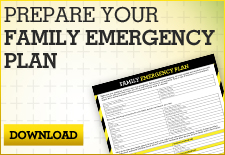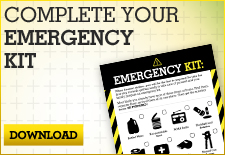
Disasters can happen… at any time. Be prepared to take action before, during and after.
Nuclear power plants use the heat generated from nuclear fission in a contained environment to convert water to steam, which powers generators to produce electricity. Nuclear power plants operate in most states in the country and produce about 20 percent of the nation’s power. Nearly 3 million Americans live within 10 miles of an operating nuclear power plant.
Local and state governments, federal agencies, and the electric utilities have detailed emergency response plans in the event of a nuclear power plant incident. The plans define two “emergency planning zones.” One zone covers an area within a 10‐mile radius of the plant, where it is possible that people could be harmed by direct radiation exposure. The second zone covers a broader area, usually up to a 50‐mile radius from the plant, where radioactive materials could contaminate water supplies, food crops and livestock.
The potential danger from an accident at a nuclear power plant is exposure to radiation. This exposure could come from the release of radioactive material from the plant into the environment, usually characterized by a plume (cloud‐like formation) of radioactive gases and particles. The major hazards to people in the vicinity of the plume are radiation exposure to the body from the cloud and particles deposited on the ground, inhalation of radioactive materials and ingestion of radioactive materials. Prior or during a nuclear power plant incident, you can find detailed information from your local television and radio stations, local emergency management agency, or local Nuclear Power Plant/Energy provider.
Before
If you live within 10 miles of the power plant, you should receive the materials yearly from the power company or your state or local government. Obtain public emergency information materials from the power company that operates your local nuclear power plant or your local emergency services office.
2 – Complete the Emergency Contacts Card and place one in your Emergency Kit.
3 – Prepare an Emergency Kit. The Emergency Kit should be easily accessible should you and your family be forced to shelter in place (stay at home) for a period of time.
During
If an accident at a nuclear power plant were to release radiation in your area, local authorities would activate warning sirens or another approved alert method. They also would instruct you through local television and radio stations on how to protect yourself. Follow all instructions closely, including the safest way to evacuate, if instructed to do so.
- If you are told to evacuate, keep car windows and vents closed; use re‐circulating air.
- Go to a designated public shelter if you have been told to evacuate or you feel it is unsafe to remain in your home. Text SHELTER + your ZIP code to 43362 (4FEMA) to find the nearest shelter in your area (example: shelter 12345). Additionally, you can contact your local chapter of the American Red Cross or your local Emergency Management Agency.
- If you are advised to remain indoors, turn off the air conditioner, ventilation fans, furnace and other air intakes.
- Shield yourself by placing heavy, dense material between you and the radiation source. Go to your shelter in place location, or a below‐ground location.
- Do not use the telephone unless absolutely necessary.
If an incident happens at a nuclear power plant, local officials will provide you with information on steps to take and how to stay safe. This includes recommendations for whether or not you may need to seek medical attention.
- If you are exposed to radiation, follow decontamination instructions from local authorities. You may be advised to take a thorough shower.
- Change exposed clothes and shoes; put exposed clothing in a plastic bag; seal it and place it out of the way.
- Seek medical treatment for unusual symptoms, such as nausea, as soon as possible.
- Keep food in covered containers or in the refrigerator. Food not previously covered should be washed before being put in to containers.



